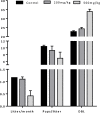Folliculogenesis Is Not Fully Inhibited during GnRH Analogues Treatment in Mice Challenging Their Efficiency to Preserve the Ovarian Reserve during Chemotherapy in This Model
- PMID: 26325271
- PMCID: PMC4556658
- DOI: 10.1371/journal.pone.0137164
Folliculogenesis Is Not Fully Inhibited during GnRH Analogues Treatment in Mice Challenging Their Efficiency to Preserve the Ovarian Reserve during Chemotherapy in This Model
Abstract
As many chemotherapy regimens induce follicular depletion, fertility preservation became a major concern in young cancer patients. By maintaining follicles at the resting stage, gonadotropin-releasing hormone analogues (GnRHa) were proposed as an ovarian-protective option during chemotherapy. However, their efficacy and mechanisms of action remain to be elucidated. Mice were dosed with cyclophosphamide (Cy, 100-500 mg/kg i.p) to quantify follicular depletion and evaluate apoptosis at different times. We observed a dose-dependent depletion of the follicular reserve within 24 hours after Cy injection with a mean follicular loss of 45% at the dose of 200mg/kg. Apoptosis occurs in the granulosa cells of growing follicles within 12 hours after Cy treatment, while no apoptosis was detected in resting follicles suggesting that chemotherapy acutely affects both resting and growing follicles through different mechanisms. We further tested the ability of both GnRH agonist and antagonist to inhibit oestrus cycles, follicular growth and FSH secretion in mice and to protect ovarian reserve against chemotherapy. Although GnRHa were efficient to disrupt oestrus cycles, they failed to inhibit follicular development, irrespective of the doses and injection sites (sc or im). Around 20% of healthy growing follicles were still observed during GnRHa treatment and serum FSH levels were not reduced either by antagonist or agonist. GnRHa had no effect on Cy-induced follicular damages. Thus, we showed that GnRHa were not as efficient at inhibiting the pituitary-gonadal axis in mice as in human. Furthermore, the acute depletion of primordial follicles observed after chemotherapy does not support the hypothesis that the ovary may be protected by gonadotropin suppression.
Conflict of interest statement
Figures




References
-
- Razzano A, Revelli A, Delle Piane L, Salvagno F, Casano S, Randaccio S, et al. Fertility preservation program before ovarotoxic oncostatic treatments: role of the psychological support in managing emotional aspects. Gynecol Endocrinol. 2014;30(11):822–4. 10.3109/09513590.2014.944153 . - DOI - PubMed
-
- Meirow D. Reproduction post-chemotherapy in young cancer patients. Mol Cell Endocrinol. 2000;169(1–2):123–31. . - PubMed
Publication types
MeSH terms
Substances
LinkOut - more resources
Full Text Sources
Other Literature Sources
Research Materials

